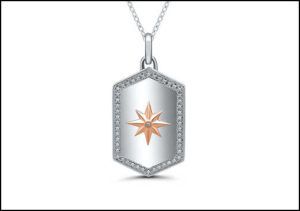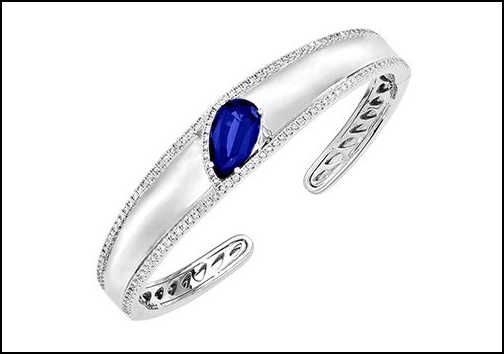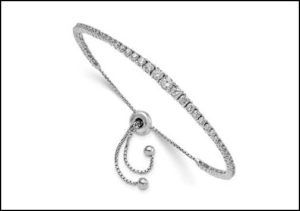Profiling Gen Z Jewelry Consumers
Gen Z uses ecommerce, personalized online shopping and on-demand services.
The U.S. jewelry market is expected to increase from about $42 billion in 2020 to over $60 billion by 2025, expects Statista. Online U.S. jewelry and watch sales are expected to reach $7.6 billion in 2021, cites IBISWorld. After an unexpected 2020, a wind of optimism is picking up now across the luxury segment.
 Among the consumer demographics most optimistic, are Generations Y and Z. Gen Zers, in particular are focused on building a better world, one that is more sustainable and fair, and they’re looking for brands that reflect their values and use technology effectively, finds The Plumb Club Industry & Market Insights 2021, developed with luxury trend-forecaster The Futurist, Paola DeLuca, and the statistical analysis survey firm, Qualtrics.
Among the consumer demographics most optimistic, are Generations Y and Z. Gen Zers, in particular are focused on building a better world, one that is more sustainable and fair, and they’re looking for brands that reflect their values and use technology effectively, finds The Plumb Club Industry & Market Insights 2021, developed with luxury trend-forecaster The Futurist, Paola DeLuca, and the statistical analysis survey firm, Qualtrics.
Born after 1997, Gen Zers comprise about 27% of the U.S. population, and is expected to be the largest generation in American history. This generation also is the most diverse, with 47% of the demographic from ethnic minorities. Pew Research expects Gen Z to be majority non-white by 2026.
The direct and indirect spending power of Gen Z is rapidly growing, reaching $44 billion in the U.S. prior to the pandemic, cites the cultural consultancy firm, Sparks & Honey. Hailed the most influential consumer group Gen Z will soon become the most pivotal generation to the future of retail, with many having enormous spending power by 2026.
Gen Zers tend to be more conservative in their spending, more wary of the future having faced the crises of 2020 during their formative years, cites TPC research. Young consumers are deeply affected by the pandemic, but are able to see opportunity for a better world to emerge post COVID, and they want to lead the change, reports the Deloitte Global Pandemic Survey 2020.
Digital Natives
As digital natives, Gen Z (aka iGen) uses ecommerce, personalized online shopping and on-demand services identifies TPC research.
 In a survey conducted for TPC Industry & Market Insights 2021 of 1,000 U.S. jewelry consumers aged 25-60, a third of respondents rate a retailer’s website as the No. 1 influencer of a jewelry purchase. The influence of “family and friends” came in second at 30%, and social media advertising ranked third at 14%.
In a survey conducted for TPC Industry & Market Insights 2021 of 1,000 U.S. jewelry consumers aged 25-60, a third of respondents rate a retailer’s website as the No. 1 influencer of a jewelry purchase. The influence of “family and friends” came in second at 30%, and social media advertising ranked third at 14%.
A jeweler’s website is its digital flagship store, and should have with product level content that educates and informs, as most consumers do their initial research online, advocates Jeffery Cohen, president of Citizen Watches America.
In fact, 79% of consumers surveyed say they research jewelry products online first, and prefer to do so on mobile devices (39%) and laptops (34%). But regardless of starting the purchasing journey online, 47% of jewelry consumers surveyed for TPC end up in store to buy, finds TPC consumer research. And they crave a store that can keep up with technology more than anything.
A majority of respondents to TPC’s consumer survey (85%) say that they are active on social media, with Facebook (93%) and Instagram (73%) most popular, and 59% are purchasing through these platforms. The preferred social media platforms for Gen Z are Instagram, TikTok, Snapchat, Pinterest, and Twitch.
Cohen advocates a customer first, digital first approach that aims to keep things easy and seamless for customers, creating awareness and demand no matter where consumers are shopping.
Since COVID, many manufacturers have been working hard to provide jewelers with digital resources, including free custom design platforms, ecommerce sites, and virtual try-on applications to engage and connect with jewelry consumers. Novell Global, for example, launched this year an online resource center for its retail partners, shares Harry Fiorentinos, director of sales for Novell, a subsidiary of Continental. NovellUniversity.com is designed to educate jewelry retailers on Novell products and business practices, while using the power of social media to drive foot traffic to their brick and mortar and/or online store.
 Technology can help ease purchase decisions by building confidence. Brian Howard, vice president of sales and marketing for Shah Luxury, says the company is having success with a virtual try-on and hologram application it created. The brand, for which half its business is custom work for jewelers, cites sales conversion rates between 30% and 40% for those using the technology.
Technology can help ease purchase decisions by building confidence. Brian Howard, vice president of sales and marketing for Shah Luxury, says the company is having success with a virtual try-on and hologram application it created. The brand, for which half its business is custom work for jewelers, cites sales conversion rates between 30% and 40% for those using the technology.
According to a new survey from Snapchat and Foresight Factory of 20,000 consumers across 12 global markets in May of this year, there will be a 37% increase (from 30% in 2021 to 41 % in 2025) in the proportion of Gen Z shoppers using Augmented Reality before buying a product.
Sustainably Sourced
Younger consumers define luxury in a way that is very different from previous generations. The pandemic has inspired consumers to reevaluate what they consider luxury, and the result, finds TPC research, is desire for rare items of premium quality and lasting value.
Forced to slow down and re-connect with Mother Nature, with old and new beliefs, jewelry is the expression of this new mindset and lifestyle. The focus is on simplicity, quality and longevity. According to TPC research, consumers today are interested in buying fewer high-quality pieces that have personal meaning, rather than buying impulsively. Less is more.
Gen Z is more of an “us” than a “me” generation, describes Valerie Fletcher, vice president of design and product development for Original Design Inc. (ODI). While personalized jewelry like nameplates, zodiacs and birthstones are still favorites personal expression in jewelry encompasses so much more for this generation, including a heightened social consciousness. “They’re very socially aware, and look for brands and products that express their values.”
They are eco-conscious, seeking products that are kinder to the environment and our neighbors, sees Monica McDaniels, communications manager for the San Marcos, California lab-grown gem brand, Chatham. “Conversations with consumers revolve around making ethical buying decisions.”
Sustainably sourced is a key influencer. In TPC’s consumer survey, 20% rank it a 10, most important, that their jewelry be responsibly sourced, with the average rank a 6.5 in significance from a scale of 1 to 10. Nearly three quarters say they’d pay more for a product sustainably sourced, with more than a quarter indicating they’d pay a lot more.
In fact, environmental concerns are most pronounced for Gen Zers, with the survey revealing that they have bought, and intend to buy, less gold jewelry than their parents. A survey by the World Gold Council cites that 70% of consumers are interested in ethically sourced gold and its impact on the people who mine it.
According to TPC consumer research, 74% of jewelry consumers (age 25-60) are interested in non-traditional jewelry materials, with colored gold and titanium most preferred. Research also reveals the importance of jewels that showcase nature themes or include natural materials like rough stones and wood.
Fletcher is thrilled ODI is launching a Greenland Ruby & Sapphire Collection at JCK Las Vegas. “As a member of the Taché Alliance, our strength has always been natural diamonds, but going into 2022, we wanted to offer something new that was natural, ethically sourced, and traceable from mine to market.
“Gen Zers are concerned with the impact of mining on the environment and local cultures, and that influences their purchases,” says Fletcher, noting that a portion of sales goes to The PinkPolarBear Foundation to support local communities, artisanal miners and wildlife.
This concern is also influencing Gen Y and Z to consider lab-grown diamonds. In fact, Cora-Lee Colaizzi, director of marketing and catalogs and senior merchandiser for Quality Gold in Fairfield, Ohio sees demand for lab-grown diamonds taking off beyond bridal. Young diamond buyers are drawn to lab-grown diamonds for the price, supply chain transparency, and environmental reasons. TPC research finds consumers ready to embrace fashion jewelry made with lab-grown diamonds, with those actively shopping for fashion diamond jewelry expressing a high level of interest in lab-grown.
 Gender Neutral
Gender Neutral
Gen Z also embraces design that is gender fluid, as Fletcher describes, jewelry that is somewhere between stereotypical masculine and feminine attributes — “ clean, classic, streamlined, and sized to be wearable on all body types.” Androgynous expressions translate, including signet rings, diamond stud earrings, dog tag pendants, charms, and link bracelets and necklaces. The pavé diamond Cuban link chain is a great example. Made in any size link and length, as a bracelet or necklace, everyone can wear this look.”
Exciting about Gen Zers is their love to experiment and follow their own paths, says Fiorentinos. Unlike previous generations, they don’t accept being put into a box. They decide what’s good for them, and don’t care what brands want them to do. They’re staying true to themselves, mixing and matching pieces as only they individually see fit. It’s a breath of fresh air, you do you!”
Novell has been focused on this design direction for Gen Y and Z, launching last year a line of commitment jewelry, BAE (Before Anyone Else), including diamond promise rings. BAE offers traditional and nontraditional, gender nonspecific, scalable and stackable styles, allowing consumers to co-create their jewelry.
TPC research also finds that gender classifications of watches have become less relevant, as more women are buying men’s watches to attain a larger case size, while the trend towards larger sizes for men has declined in recent years.









